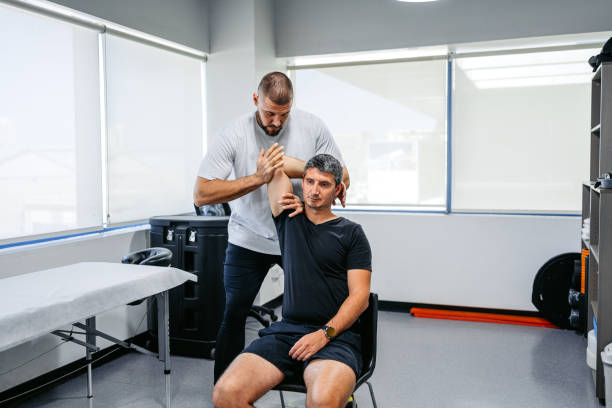Desk Job Struggles? How Chiropractic Eases Workplace Pain

Desk Job Struggles? How Chiropractor in Vaughan Can Ease Workplace Pain
Introduction: When Your Desk Job Takes a Toll on Your Body
Let’s face it, desk jobs are sneaky. They might seem harmless, but after hours of sitting, staring at a screen, and poor posture habits, your body starts to fight back. Sound familiar? If you’re dealing with chronic neck stiffness, back pain, tension headaches, or wrist soreness, you’re not alone. These are some of the most common complaints among professionals with sedentary office jobs. That’s where seeing a chiropractor in Vaughan could be your game-changer. Chiropractic care offers natural, non-invasive relief from workplace-related aches and pains—no medications or surgeries required.
What Is Chiropractic Care and Why Is It Important for Desk Workers?
Understanding Chiropractic Treatment
Chiropractic care focuses on diagnosing and treating musculoskeletal issues, especially those involving the spine, joints, and nervous system. Chiropractors use spinal adjustments, mobilization, soft tissue therapies, and ergonomic advice to restore balance in your body.
Why Desk Jobs Cause Trouble
The human body wasn’t designed to sit for eight hours a day. Common desk job problems include:
- Forward head posture
- Rounded shoulders
- Lower back compression
- Reduced circulation
- Muscle tightness and joint restrictions
The Role of a Chiropractor in Vaughan for Office-Related Pain Relief
A Chiropractor in Vaughan can help you tackle the root cause of your pain, not just the symptoms. Whether it’s chronic back pain, tension headaches, or poor posture, chiropractic care aims to correct spinal misalignments that often go unnoticed but impact your overall function.
Top Conditions Treated by Chiropractors for Desk Job Employees
1. Tension Headaches and Migraines
Sitting in one position for too long can increase tension in your neck and shoulders, triggering headaches. Chiropractic adjustments can relieve pressure and reduce frequency.
2. Lower Back Pain
One of the most common complaints among office workers. Spinal manipulation improves joint mobility, reduces inflammation, and relaxes muscles.
3. Carpal Tunnel and Wrist Pain
Repetitive typing and mouse usage strain the wrists and forearms. Chiropractors offer adjustments and exercises to improve wrist mobility and function.
4. Shoulder and Neck Stiffness
Poor monitor height or phone positioning often causes stiffness. Chiropractors correct spinal alignment to restore natural posture.
How Chiropractic Treatment Works: Step-by-Step
Step 1: Comprehensive Assessment
Your chiropractor will assess your posture, spine alignment, and musculoskeletal health.
Step 2: Personalized Treatment Plan
Depending on your needs, you may receive spinal adjustments, soft tissue therapy, corrective exercises, and ergonomic advice.
Step 3: Progress Monitoring
Improvements in pain, flexibility, and range of motion are monitored, and your plan is adjusted accordingly.
Ergonomics and Chiropractic Care: The Perfect Duo
Your chiropractor isn’t just about adjustments. They also offer:
- Ergonomic desk evaluations
- Stretching routines for office breaks
- Advice on chair positioning and screen height
- Footrest and lumbar support tips
These changes can drastically reduce the recurrence of workplace pain.
Why Choose PhysioChiroWellness for Chiropractic in Vaughan?
At PhysioChiroWellness, we take a personalized approach to treating workplace-related musculoskeletal pain. Our team of experienced chiropractors combines manual therapy, corrective exercise, and ergonomic guidance to help you move and feel better—naturally.
We proudly serve clients from Vaughan and nearby communities who are tired of letting pain rule their workdays.
Evidence-Based Chiropractic Benefits
According to the Canadian Chiropractic Association and Government of Canada health resources:
- Chiropractic care reduces musculoskeletal disability.
- It improves function in chronic low back pain and neck pain sufferers.
- Patients receiving chiropractic care often require fewer pain medications and recover faster.
(Reference: Government of Canada – Chronic Pain Fact Sheet)
Patient Testimonials
“After just a few sessions at PhysioChiroWellness, my back pain from sitting all day vanished. I finally feel human again!” — Randy, Vaughan
“The team helped me fix my posture and gave me stretching tips that I use every day at work.” — Michael A., Vaughan
Quick Tips for Office Workers: Stay Pain-Free Between Visits
- Stand and stretch every 30-60 minutes
- Adjust your monitor to eye level
- Use a chair with lumbar support
- Keep your feet flat on the floor
- Don’t cradle your phone between shoulder and ear
These small adjustments can make a big difference.
Take the First Step Toward a Pain-Free Work Life
Work shouldn’t hurt. If you’re feeling the physical toll of your 9-to-5, a Chiropractor in Vaughan might be the natural solution you’ve been looking for.
Ready to break free from desk-job discomfort?
Schedule your personalized consultation with PhysioChiroWellness today by clicking here.
FAQs About Chiropractic Care for Office Pain
1. Is chiropractic care safe for daily office pain?
Yes! When performed by a licensed chiropractor, it’s a safe, non-invasive treatment for chronic pain and poor posture.
2. How often should I see a chiropractor if I work at a desk?
It depends on your pain level and condition. Some patients benefit from weekly visits, others need monthly maintenance.
3. Can chiropractic care prevent pain before it starts?
Absolutely. Preventative care helps maintain spinal alignment, reduces stress, and prevents injury.
4. Will my insurance cover chiropractic visits?
Many Canadian health insurance plans cover chiropractic care. Check with your provider for details.
5. What should I wear to my appointment?
Comfortable, loose-fitting clothes are best for full mobility during assessments and treatments.
